
Black aphids on a scallion plant
If you don’t check your scallions regularly for pests, someone other than you may wind up feasting on the young plants. Be on the lookout for pests that like to chow down on scallions from leaf tip to shank.
Slugs
Slugs eat large holes in the scallion leaves or eat the leaves completely. You’ll find evidence of their nighttime foraging when you go to the garden in daylight—look for the slime trail. Slugs are mostly a problem in damp weather.
Solutions:
Pick them off by hand and put them somewhere else in your yard.
Set a beer trap. Dig a hole nearby and put a large cup or bowl in the hole; make sure the container has steep sides so the slug can’t crawl back out. Fill the cup/bowl about 3/4 full of beer. Let it sit overnight. In the morning, you should have a cup full of dead slugs you can toss out near the bird feeder.
Set a cornmeal trap. Put a couple tablespoons of cornmeal in a jar and leave it on its side near your scallion plants. Slugs like the smell of cornmeal, but they can’t digest it and will kill them.
Build a barrier. Diatomaceous earth or coffee grounds make a great “wall” to put around your scallion plants; slugs can’t crawl over them.
Thrips
Thrips are small insects that are hard to spot because of their size. But they attack the scallion leaves, which develop silvery-white streaks or blotches. Since this is the main edible part of the scallion, thrips can present a real threat to your harvest.
Solutions:
Blast ‘em. Late in the morning or on a sunny day when the leaves can dry off easily, use your garden hose to blast the tiny invaders off your plants. That should take care of most of them.
Spray ‘em. If a blast from the garden hose doesn’t do the job, then apply insecticidal soap to leaves, making sure to coat them thoroughly.
Onion Maggots
Onion maggots attack the bulb of the plant rather than the leaves. But if your scallions get an onion maggot infestation, you could lose your whole crop.
Solutions:
Check the bulbs. If they look like they’re filled with tiny tunnels, harvest what you can of the leaves and destroy the infected plants (that means throw out; never compost or burn infected/diseased plant material).
Cutworms
These nasty little creatures will cut off your scallions right at the soil level. You’ll notice they’re attacking your scallions when you see the leaves start to fall off.
Solutions:
Collar the plant. Cut the base out of a paper cup and secure it around the base of your scallion plant, like a wall.
Weed. If you weed on a regular basis, you should be able to keep the cutworms at bay. They like to lay their eggs on the weeds, then head over to the scallions to eat.
Do pests attack your scallion plants every year? How do you handle removing them—and even preventing them in the first place? Please tell us how you treat your scallion plants to avoid pests.


 Previous
Previous

